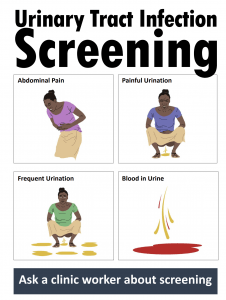Monitoring and Evaluation Framework—Ukweli Test Strips |
|||||||
|
Goal |
Outcomes |
Output |
|||||
|
Indicator |
Reduction in the maternal mortality of Sierra Leone. | Number women who are screened positive for Urinary Tract Infections and/or Preeclampsia | Women are empowered to take charge of the healthcare of themselves and their neonate. They stop doing nothing when symptoms emerge. | ||||
|
Definition |
Over a longer period of time i.e. 5 years, there is a reduction in the reported number of women dying due to pregnancy | Records kept by CHWs and PHUs that are translated to the Ukweli Employees—the no. of people screened and their health outcomes | Track how many times women got screened or were referred somewhere else to get screened. Shows initiative to actually do something | ||||
|
Baseline |
1,360 maternal deaths per 100,000 live births | Information is not available | Gabi’s study | ||||
|
Target |
1,300 maternal deaths per 100,000 live births | Approximately 90% of the Bombali district screened by the 3rd year of operation. | A noticeable increase in women who come to doctors to get screened / talk about their health in regards to UTI / Pree | ||||
|
Data Source |
Publications from Sierra Leone Pharmacy Control Board/ Ministry of Health or publications from the World Health Organization | Records kept by the CHWs and PHUs that are communicated to the Ukweli employee | Utilize records made up by Ukweli of how many women are screened | ||||
|
Frequency |
Unfortunately, the frequency of the data is subject to the publications of the MOHS, PCB, and WHO. These publications will likely occur once every 5-10 years | Monthly | This could be monitored pretty frequently to get an idea of the change in attitude | ||||
|
Responsible |
Ukweli employees are responsible for the monitoring and the data collection of the venture. | See data source.—Ukweli Employees | The health workers who are administering the strips/talking to patients about their symptoms/referring | ||||
|
Reporting |
Statistics will be reported to the Sierra Leonean Government and external global health programs | Outcomes are to be reported to WHI, MOHS, and funding partners. | This output would be reported to World Hope, the Ukweli Team, and possibly government organizations | ||||
Key Assumptions |
|||||||
|
|||||||
Logic Model |
|||||||
| Inputs | Activities | Outputs | Outcomes | Goal Alignment | |||
| -Funding
-Partnerships with OEM / WHI -Ukweli Team |
-Delivery of test strips to PHU
-Training of the CHWs -Screening of Community Members |
-No. of women screened
-No. of women that screened pos. -No. of women referred to clinics |
-Better health outcomes for mother and neonate
-Reduction in the maternal mortality |
100% | |||
The Social Return on Investment for Ukweli |
|||||||
| The social return on investment as I understand it is how the community and/or key stakeholders benefit from Ukweli’s operations. The most direct outcome of Ukweli is an improvement of the health outcomes associated with mothers and neonates. Outside of this very specific sphere, there are other social returns that may be analyzed. The first is the number of children that survive i.e. higher birth rate—this can be measured through the number of children in school. Another social return could be the amount of capital that these families have. For example, if a family has more capital than they would likely have more livestock and therefore not spending excess capital on health expenses that could have been prevented. Another social return could be capacity building due to preeclampsia screening. To clarify, Sierra Leone may not have the capacity to treat preeclampsia right now, however with this venture we can document a clear need and the government can direct funds to support preeclampsia care | |||||||



